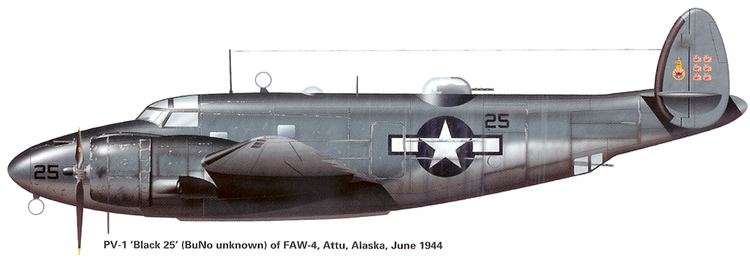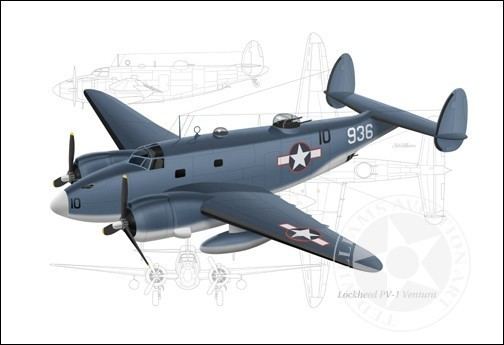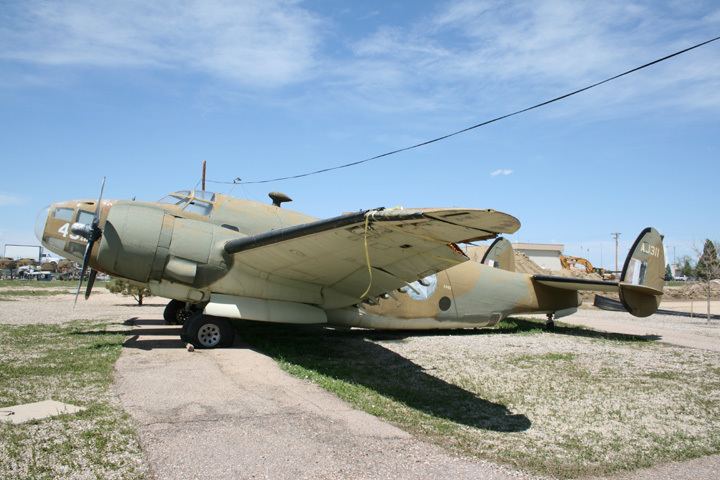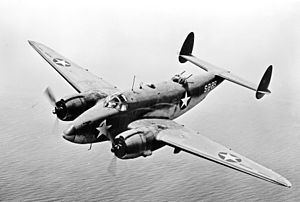Top speed 518 km/h Length 16 m | Wingspan 20 m First flight July 31, 1941 Designer Lockheed Corporation | |
 | ||
Lockheed ventura harpoon b 37
The Lockheed Ventura is a twin engine medium bomber of World War II, used by United States and British Commonwealth forces in several guises, including maritime patrol.
Contents
- Lockheed ventura harpoon b 37
- Lockheed VenturaB 34 Lexington
- Lockheed B 37
- PV 1 Ventura
- PV 2 Harpoon
- Civil conversions
- Royal Air Force
- Royal Australian Air Force
- Royal Canadian Air Force
- South African Air Force
- Soviet Air Force
- Royal New Zealand Air Force
- United States Army Air Forces
- United States Navy
- Other operators
- Variants
- Operators
- Australia
- Brazil
- Canada
- New Zealand
- South Africa
- United States
- Specifications B 34 Lexington
- References

The Ventura was developed from the Lockheed Model 18 Lodestar transport, as a replacement for the Lockheed Hudson bombers then in service with the Royal Air Force. Used in daylight attacks against occupied Europe, they proved to have weaknesses and were removed from bomber duty and some used for patrols by Coastal Command.

After United States Army Air Forces (USAAF) monopolization of land-based bombers was removed, the US Navy ordered a revised design which entered service as the Harpoon for anti-submarine work.

Lockheed Ventura/B-34 Lexington

The Ventura was very similar to its predecessor, the Lockheed Hudson. The primary difference was not in layout; rather, the Ventura was larger and heavier than the Hudson. The RAF ordered 188 Venturas in February 1940. They were delivered from mid-1942 onwards. Venturas were initially used for daylight raids on occupied Europe. Like some other RAF bombers, they proved too vulnerable without fighter escorts, which was problematical for long-range missions. They were replaced in this role by the very fast de Havilland Mosquito. The Venturas were gradually transferred to patrol duties with Coastal Command; 30 went to the RCAF and some to the SAAF.

The RAF placed a further order for 487 Ventura Mark IIs, but many of these were diverted to USAAF service. The USAAF placed its own order for 200 Ventura Mark IIA, which were put into service as the B-34 Lexington, later redesignated RB-34.
Lockheed B-37
In August 1941, large orders for Venturas were placed with Lend-Lease Act money. Among the orders were for 550 armed reconnaissance versions of the Ventura. This aircraft was originally planned to be built under the designation O-56. The main differences between the Ventura and the O-56 were in the engines: rather than the 2,000 hp (1,491 kW) Pratt & Whitney R-2800 radials of the Ventura, the O-56 used 1,700 hp (1,270 kW) Wright R-2600-13 radials.
Before completion of the first O-56, the U.S. Army Air Forces dropped the "O-" category used to designate "observation" (reconnaissance) aircraft. The O-56 was redesignated the RB-34B (the R denoted 'restricted' meaning it was not to be used for combat). Before the first of these flew, the design was redesignated again as the B-37 with a higher powered version of the R-2600, later it also was designated the RB-37.
While 550 were ordered by the Army Air Forces, acquisition by the USAAF stopped after only 18 Venturas were accepted, when the Army Air Forces agreed to turn over exclusive use of the Ventura to the United States Navy.
PV-1 Ventura
The PV-1 Ventura, built by the Vega Aircraft Company division of Lockheed (hence the "V" Navy manufacturer's letter that later replaced the "O" for Lockheed), was a version of the Ventura built for the U.S. Navy (see Venturas in U.S. Navy service below). The main differences between the PV-1 and the B-34 were the inclusion of special equipment in the PV-1, adapting it to its patrol bombing role. The maximum fuel capacity of the PV-1 was increased from 1,345 gal (5,081 l) to 1,607 gal (6,082 l), to increase its range; the forward defensive armament was also reduced for this reason. The most important addition was of an ASD-1 search radar.
Early production PV-1s still carried a bombardier's station behind the nose radome, with four side windows and a flat bomb-aiming panel underneath the nose. Late production PV-1s dispensed with this bombardier position and replaced it with a pack with three 0.50 in (12.7 mm) machine guns underneath the nose. These aircraft could also carry eight 5 in (127 mm) HVAR rockets on launchers underneath the wings.
The PV-1 began to be delivered in December 1942, and entered service in February 1943. The first squadron in combat was VP-135, deployed in the Aleutian Islands in April 1943. They were operated by three other squadrons in this theatre. From the Aleutians, they flew strikes against bases in Paramushiro and Shimushu, Japanese islands in the Kurile chain. Often, PV-1s would lead B-24 bomber formations, since they were equipped with radar. In late 1943, some PV-1s were deployed to the Solomon Islands as night fighters with VMF(N)-531, a Marine Corps fighter squadron.
PV-2 Harpoon
The PV-2 Harpoon was a major redesign of the Ventura with the wing area increased from 551 ft² (51.2 m²) to 686 ft² (63.7 m²) giving an increased load-carrying capability, and which first flew on 3 December 1943. The motivation for redesign was weaknesses in the PV-1, which had shown itself to have problems in taking off when carrying a full load of fuel. On the PV-2, the armament became standardized at five forward-firing machine guns. Many early PV-1s had a bombardier's position, which was deleted in the PV-2. Some other significant developments included the increase of the bombload by 30% to 4,000 lb (1,800 kg), and the ability to carry eight 5-inch (127 mm) HVAR rockets under the wings.
While the PV-2 was expected to have increased range and better takeoff, the anticipated speed statistics were projected lower than those of the PV-1, due to the use of the same engines but an increase in weight. The Navy ordered 500 examples, designating them with the popular name Harpoon.
Early tests indicated a tendency for the wings to wrinkle dangerously. As this problem could not be solved by a 6 ft (1.8 m) reduction in wingspan (making the wing uniformly flexible), a complete redesign of the wing was necessitated. This hurdle delayed entry of the PV-2 into service. The PV-2s already delivered were used for training purposes under the designation PV-2C. By the end of 1944, only 69 PV-2s had been delivered. They finally resumed when the redesign was complete. The first aircraft shipped were the PV-2D, which had eight forward-firing machine guns and was used in ground attacks. When World War II ended, all of the order was cancelled.
With the wing problems fixed, the PV-2 proved reliable, and eventually popular. It was first used in the Aleutians by VP-139, one of the squadrons that originally used the PV-1. It was used by a number of countries after the war’s end, but the United States ceased ordering new PV-2s, and they were all soon retired from service.
Civil conversions
Ex-military PV-1 Venturas from Canada and South Africa were converted by Howard Aero in San Antonio, Texas in the 1950s and 1960s as high-speed executive transports. The earliest conversions, called Super Venturas, incorporated a 48 in (122 cm) fuselage stretch, extra fuel tankage, large picture windows, luxury interiors, and weapons bays transformed into baggage compartments. The landing gear was swapped for the heavier-duty units from the PV-2. Later conversions, of which eighteen were completed in the 1960s, were called Howard 350s.
At least nineteen PV-1s were further modified, including cabin pressurization under the designation Howard 500. A final PV-1 modification by Howard was the Eldorado 700, with longer wings, a pointed nose, and streamlined engine cowlings.
A notable crash of a civilian version occurred on December 17, 1954, killing four, including Fred Miller, president of the Miller Brewing Company and grandson of founder Frederick Miller. The company plane was bound for Winnipeg, Manitoba, but had trouble with both engines and crashed shortly after takeoff from Mitchell Field in Milwaukee, Wisconsin. Also killed were his oldest son, 20-year-old Fred, Jr., and the two company pilots, Joseph and Paul Laird.
Royal Air Force
The first Ventura Mark Is were accepted by the Royal Air Force in September 1941, with aircraft starting to arrive in the United Kingdom in April 1942. By the end of August that year, enough Venturas had been ferried over the Atlantic to equip three Squadrons, No. 21 Squadron RAF, No. 487 Squadron RNZAF and No. 464 Squadron RAAF. The Ventura flew its first combat mission for the RAF on 3 November 1942, when three Venturas of 21 Squadron were sent against railway targets near Hengelo, the Netherlands. On 6 December 1942, 47 Venturas from 21, 464 (RAAF) and 487 (RNZAF) squadrons were part of a No. 2 Group escorted daylight raid, with 36 Bostons and 10 Mosquitos, on a low-altitude attack against the Philips radio and vacuum tube factories at Eindhoven, also in the Netherlands. This was the primary event that demonstrated the Ventura's weakness in such raids: nine of the 47 Venturas were shot down (along with four Bostons and one Mosquito), and many others were damaged by flak or bird strikes. Following this, the aircraft were switched to medium altitude raids, but fared little better. During an attack on a power station in Amsterdam on 3 May 1943, New Zealand's 487 Squadron was told the target was of such importance that the attack was to be continued regardless of opposition. All 10 Venturas that crossed the coast were lost to German fighters. Squadron Leader Leonard Trent, (later the last of the Great Escapers), won the Victoria Cross for his leadership in this raid.
The Ventura was never very popular among RAF crews. Although it was 50 mph (80 km/h) faster and carried more than twice as many bombs as its predecessor, the Hudson, it proved unsatisfactory as a bomber. By the summer of 1943 the Ventura had been phased out of service in favor of the de Havilland Mosquito. Its last mission was flown by No. 21 Squadron RAF on 9 September 1943. After leaving bombardment service, a number were modified to be used by Coastal Command; in the coastal role they served as the Ventura G.R.I.. A total of 387 PV-1s were used by the RAF as the Ventura G.R.V. They were used in the Mediterranean and by Coastal Command. Some RAF aircraft were modified into Ventura C.V transport aircraft.
A small number of Venturas were also used in other countries, including Canada's Royal Canadian Air Force the Royal New Zealand Air Force and South Africa.
Royal Australian Air Force
In the United Kingdom 464 Squadron was formed at RAF Feltwell to operate the Ventura as part of Bomber Command's No. 2 Group, it converted to the De Havilland Mosquito in September 1943.
A total of 55 PV-1s were used by the RAAF in the South West Pacific Area, serving primarily in New Guinea. A large order of new machines from the RAF in 1939 meant Lockheed could readily supply to the RAAF. Only the RAAF used them in front line combat, bombing the north coast of New Guinea. Initially, air crews and ground staff disliked the Ventura, preferring the North American B-25 Mitchell. But in many cases, the PV-1 had developed a grudging respect from its operators. More RAAF machines were lost on the ground than in the air, both from attack and the bad handling characteristics at landing speeds. They were replaced by other more capable machines, including B24s, and DAP Beauforts and Beaufighters.
Royal Canadian Air Force
A total of 157 Ventura G.R. Mk. Vs were used operationally by the RCAF from 16 June 1942 to 18 April 1947 in the home defence coastal patrol role in both Eastern and Western Air Command. They were flown by 8, 113, 115, 145, and 149 Squadrons. A further 21 Ventura Mk. Is and 108 Ventura Mk. IIs were used in a training role at 1 Central Flying School, Trenton, Ontario, and at RCAF Station Pennfield Ridge, New Brunswick (RAF No. 34 Operational Training Unit) as part of the BCATP. A total of 21 Mk. Is, 108 Mk. IIs, and 157 G.R. Mk. Vs were in service during this period for a total of 286 aircraft.
South African Air Force
The South African Air Force also received some 135 PV-1s, which were used to protect shipping around the Cape of Good Hope and to bomb Italian shipping in the Mediterranean. In December 1942 four SAAF Venturas dropped supplies to survivors of the Dunedin Star shipwreck on South-West Africa's Skeleton Coast. Venturas served in the South African Air Force until 1960.
Soviet Air Force
A few US Navy PV-1s force-landed in the Soviet Union after attacking Japanese targets on the Kurile islands and were impounded. Some of them were repaired and pressed into service by the Soviet Air Force where the type became known as the B-34. By December 1944, eight planes were located on airfields on Kamchatka: four were fully airworthy, three were undergoing repairs and one was a write-off.
By 1945 seven PV-1s (five of them being airworthy) were used by the Soviets, one plane was the personal liaison aircraft of Ltc M.A. Yeryomin. The planes were used during the Soviet-Japanese campaign in August 1945. After the end of the war only one aircraft remained in service.
Royal New Zealand Air Force
From August 1942, No. 487 Squadron RNZAF, (operating in Europe as part of the Royal Air Force), was equipped with the type, although losses (including on 3 May 1943 the loss of all 11 aircraft attacking Amsterdam), lead to their replacement with the de Havilland Mosquito in June.
The Royal New Zealand Air Force in the Pacific received 139 Venturas and some Harpoons from June 1943 to replace Lockheed Hudsons in the maritime patrol bomber and medium bomber roles. Initially Venturas were unpopular with the RNZAF due to rumoured poor performance on one engine, the fate of Squadron Leader Leonard Trent VC's 487 Squadron (above) as well as the failure of the U.S. to provide New Zealand with promised B-24 Liberators. Despite that the RNZAF Venturas came to be among the most widely used of any nation's, seeing substantial action until VJ Day over South West Pacific islands.
The first 19 RB-34s that arrived by sea from the U.S. in June had much equipment either missing or damaged. Six airworthy machines were hurriedly produced by cannibalization and sent into action with No. 3 Squadron RNZAF in Fiji. On 26 June the first PV-1s were flown to Whenuapai and No. 1 Squadron RNZAF was able to convert to 18 of these by 1 August, then replacing the mixed 3 Squadron in action at Henderson Field, Guadacanal in late October.
By this time No. 2 Squadron RNZAF at Ohakea and No. 9 Squadron RNZAF were also using the type. The following year No. 4 Squadron RNZAF and No. 8 Squadron RNZAF also received Venturas. Some squadrons were retained on garrison duty while others followed the allied advance to Emirau and Green Island and to New Britain. RNZAF Venturas were tasked with routine patrols, anti-shipping strikes, minelaying, bombing and strafing missions, air-sea rescue patrols, and photographic reconnaissance missions. In an apparently bizarre case of taking Lockheed's marketing slogan of The Fighter-Bomber too literally, even briefly, Venturas conducted fighter sweeps.
RNZAF machines often clashed with Japanese fighters, notably during an air-sea rescue patrol on Christmas Eve 1943. NZ4509 was attacked by nine Japanese single-engined fighters over St. George's Channel. It shot down three, later confirmed, and claimed two others as probables, although it suffered heavy damage in the action. The pilot, Flying Officer D. Ayson and navigator, Warrant Officer W. Williams, were awarded the DFC. The dorsal turret gunner Flight Sergeant G. Hannah was awarded the DFM.
By late 1944 the Ventura began to be phased out of front line action as the RNZAF backed away from the Patrol Bomber concept, orders for PV-2 Harpoons were canceled after a handful or aircraft had been delivered. At VJ Day only 30 PV-1 aircraft remained on the front-line with No. 3 Squadron at Jacquinot Bay.
Planned re-equipment with de Havilland Mosquitos did not take place until after the cessation of hostilities. The last Ventura unit was No. 2 Squadron, which continued to operate PV-1 and PV-2 aircraft on meteorological duty until 1948. A restored RNZAF RB-34 (NZ4600) is owned by the Museum of Transport and Technology in Auckland.
United States Army Air Forces
Some 264 Ventura Mark IIs ordered by the RAF were seized by the U.S. Army Air Forces. Though some were used as anti-submarine patrol bombers under the designation B-34 Lexington, most were used for training with various stateside units. 27 of these were used by the United States Navy for anti-submarine patrols as well; these were designated PV-1 Ventura and PV-2 Harpoon.
United States Navy
During the early months of 1942, the primary responsibility for anti-submarine warfare in the United States was shouldered by the Army Air Forces. This irked the Navy, as it considered this region of battle its burden. To carry out such a task, the Navy was pursuing a long-range, land-based patrol and reconnaissance aircraft with a substantial bombload. This goal was always resisted by the Army Air Forces, which carefully protected its monopoly on land-based bombing. This forced the navy to use long-range floatplanes for these roles. The Navy was unable to upgrade to more capable aircraft until the Army Air Forces needed the Navy plant in Renton, Washington to manufacture its Boeing B-29 Superfortress. In exchange for use of the Renton plant, the Army Air Forces would discontinue its objections to Naval land-based bombers, and provide aircraft to the Navy. One of the clauses of this agreement stated that production of the B-34 and B-37 by Lockheed would cease, and instead these resources would be directed at building a navalized version, the PV-1 Ventura.
The PV-1 began to be delivered in December 1942, and entered service in February 1943. The first squadron in combat was VP-135, deployed in the Aleutian Islands in April 1943. They were operated by three other squadrons in this theatre. From the Aleutians, they flew strikes against Paramushiro, a Japanese island. Often, PV-1s would lead B-24 bomber formations, since they were equipped with radar. In late 1943, PV-1s were deployed to the Solomon Islands and to the newly captured field at Tarawa in the Gilbert Islands.
After the war, the U.S. Navy deemed many PV-1s as obsolete and the aircraft were sent to Naval Air Station Clinton, Oklahoma to be demilitarized and reduced to scrap.
Other operators
Variants
Operators
Australia
Brazil
Canada
New Zealand
South Africa
United States
Aircraft is on loan from the National Naval Aviation Museum.
Specifications (B-34 Lexington)
Data from
General characteristics
Performance
Armament
